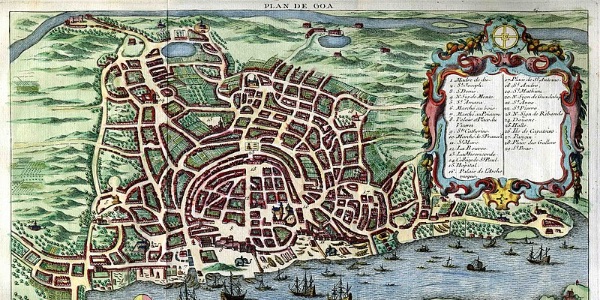Sanjay Subrahmanyam’s latest book, Europe’s India: Words, People, Empires, 1500-1800 is an erudite study of European understandings of India in the early modern period. It will be immensely useful to historians and literary scholars of early modern India, and those interested in European interactions with the subcontinent, writes Professor Javed Majeed.
 Sanjay Subrahmanyam’s Europe’s India: Words, People, Empires, 1500-1800 is an erudite study of European understandings of India in the early modern period. Subrahmanyam complicates the three common trajectories used to plot European knowledge of India between 1500 and 1800 (for a succinct summary of these trajectories, see pp. xv-xvi). Rather than deploying these teleological trajectories Subrahmanyam shows how different forms of knowledge production co-existed in the same texts, with their adherents often struggling with each other. The result is a series of vignettes of individual European travellers, diplomats and savants, combined with a fine-grained reading of their texts and close attention to historical and political context. Throughout Subrahmanyam avoids using the lugubrious terminology of postcolonial studies, and the result is a lucid and elegant exposition of the shifts in and different styles of Europe’s attempts to know India in this period.
Sanjay Subrahmanyam’s Europe’s India: Words, People, Empires, 1500-1800 is an erudite study of European understandings of India in the early modern period. Subrahmanyam complicates the three common trajectories used to plot European knowledge of India between 1500 and 1800 (for a succinct summary of these trajectories, see pp. xv-xvi). Rather than deploying these teleological trajectories Subrahmanyam shows how different forms of knowledge production co-existed in the same texts, with their adherents often struggling with each other. The result is a series of vignettes of individual European travellers, diplomats and savants, combined with a fine-grained reading of their texts and close attention to historical and political context. Throughout Subrahmanyam avoids using the lugubrious terminology of postcolonial studies, and the result is a lucid and elegant exposition of the shifts in and different styles of Europe’s attempts to know India in this period.
The first two chapters are particularly illuminating for historians of early modern India. Here Subrahmanyam gives us a nuanced account of Portuguese texts such as João de Barros’ three-volume Da Ásia (1552-1563, with a fourth posthumous volume in 1615). Rather than presenting it as simply defining and defending an ideology of empire-building, Subrahmanyam draws attention to the complexity of the work, pointing to de Barros’ stress on the authenticity of the source materials he used, particularly Persian and Arabic tārīkh literature. For de Barros, the nature of the crónica as a genre of writing required an encounter with tārīkh, which itself was being modified, partly because of the need to deal with new elements such as the Portuguese themselves. Thus, Subrahmanyam is sensitive not just to the vagaries of knowledge production, but also the changes in the formal features of the texts expressing that knowledge across European-Indian cultural and linguistic boundaries.
Moreover, in outlining the importance of lei (roughly, ‘law’) rather than casta in Indo-Portuguese reflections on collective Indian identities before 1530, he also contributes to debates about the genealogy of caste as a sociocultural concept in European accounts of India’s social systems and religion. He points out that it was only in the second half of the 16th century that casta emerges as the dominant term to describe social groups and categories in the context of Portuguese India, although it bore a range of meanings, beyond what we today think of as ‘caste’. In texts using this term, such as Agostinho de Azevedo’s late 16th century ‘Of the Opinions, Rites and Ceremonies of All the Gentiles of India’, we begin to see the presentation of ‘gentile’ (for which, read ‘Hindu’) belief and society as more systemic than in previous texts.
Again, Subrahmanyam is alive to the complexity of this text, highlighting its key references from southern India and Azevedo’s mediated access to some form of Sanskrit textual knowledge. Interestingly, Azevedo’s work was incorporated into later chronicles and texts, such as Da Ásia, and his role was effaced in the process, although his understanding stayed in place. Thus, we also discover how the major texts in the European knowing of India were built up through borrowings and wholesale incorporations from previous accounts. At times, this could produce an unwieldy coalescence of texts within one book, as was the case with Bernard Picart and Jean-Frédéric Bernard’s Cérémonies et coutumes religieuses de tous les peoples du monde (1723-1737), in which there is a dialogical and critical encounter between their footnotes and the texts that are part of their compilation. Here Subrahmanyam gives us an illuminating and insightful account of this canonical text in the development of early modern European knowledge of India, outlining the epistemological effects of its compilation and the logic of inclusion and exclusion. In particular, he traces how in this coalescence of texts presuppositions about Christian monotheism shaped views on the religion of the ‘gentiles’, with authors struggling to frame the latter through Biblical narratives and motifs. As such, Europe’s India is also a useful intervention in the study of inter-religious understandings in the early modern period.

A Portuguese map of Goa from 1750. Image: Public domain.
Subrahmanyam also makes the point that by the beginning of the 16th century, representing India in Europe became linked to collecting objects and written materials on the former. Chapter 3 is a fine exposition of British collections of Persian manuscripts, especially through the career of the Scotsman James Fraser (1712-54). What is particularly interesting is how Fraser used categories of classification which he imbibed through his dealings with Persian-speaking literati in Surat and Khamabyat for his own collection. His own The History of Nadir Shah (1742) is a hybrid work which includes materials provided by other contemporaries and copies and translations of contemporary documents. In doing so, it departs from received wisdom, both on Nadir Shah and Aurangzeb in important respects. As Subrahmanyam argues, examining a spectrum of such apparently “minor” figures as Fraser gives us a closer sense of how Europeans experienced and comprehended India before the age of their empire.
The transition to “colonial knowledge” again presents us with revealing vignettes, this time of four figures, Dom António José de Noronha (b. 1720), Charles de Bussy (b. 1720), Colonel Antoine-Louis-Henri Polier (1741-1795), and the Scotsman Alexander Walker (1764-1831). These four figures were not thinkers as such; rather they conceived India through their dealings with local interlocutors, and represented points of view constructed in the thick of action. Walker is a transitional figure, active in India during the period when the East India Company was being transformed from a mercantile company into a colonial state, and this is reflected in the telling ambiguities in his work, and his eclectic approach to scholarship, all of which Subrahmanyam discusses with verve and an eye for revealing details.
Subrahmanyam ends with a discussion of 18th century accounts by Indians who travelled to Europe; particularly interesting here is his examination of a late 18th century Malayali travel account by Paremmakal Tommakattanar (1736-1799), in which he discusses the changing relations between the Catholic Church and the Syrian Christians of Kerala and its impact on Tommakattanar, a Syrian Christian man of the cloth who accompanied the Bishop Mar Joseph Kariyattil, to Iberia and Rome in 1779-80. As such, it expands our knowledge of Indian travel accounts, beyond the focus on Mirza Abu Talib Khan and Mirza Shaikh I’tisam-ud-Din, who have been examined in some detail by previous scholars.
Europe’s India will be immensely useful to historians and literary scholars of early modern India, and those interested in European interactions with the subcontinent. It should be read alongside other seminal historiographical texts such as Chris Bayly’s Empire and Information (1996), which treats the later period of 1780-1870. Subrahmanyam’s sensitivity to both the forms of European texts and the content of knowledge production is very welcome, as is his focus on these texts as material objects which often bore interesting pictorial illustrations, themselves revealing of the aesthetics of ethnographic encounters in India. Although Subrahmanyam discusses the fractious debates on and about Orientalism throughout his book, he does not get bogged down by these, or get trapped into any conceptual corners in an attempt to resolve issues which cannot always be resolved. Rather than opting for polemic or simplicity, he lays out for us the dense singularity and eclecticism of these texts and manuscripts, and the complexity of the contexts in which they were embedded and out of which they emerged.
This article gives the views of the author, and not the position of the South Asia @ LSE blog, nor of the London School of Economics. Please read our comments policy before posting.
About the Author
Javed Majeed joined King’s College London as Professor of English and Comparative Literature in January 2012, having taught at Queen Mary’s and SOAS, University of London. His publications include Muhammad Iqbal: Islam, Aesthetics and Postcolonialism (Routledge, 2008) and Autobiography, Travel and Postnational Identity. Nehru, Gandhi and Iqbal (Palgrave Macmillan, 2007). He is currently writing a book on the Linguistic Survey of India, conducted by the colonial state under the supervision of Sir George Abraham Grierson (1851-1941) in the late 19th and early 20th centuries.







